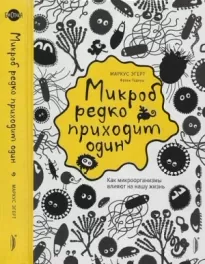Микроб редко приходит один. Как микроорганизмы влияют на нашу жизнь

- Автор: Маркус Эгерт
- Жанр: Биология
- Дата выхода: 2020
Читать книгу "Микроб редко приходит один. Как микроорганизмы влияют на нашу жизнь"
2. Микроб редко приходит один
Barker J & Bloomfield SF (2000) Survival of Salmonella in bathrooms and toilets in domestic homes following salmonellosis. Journal of Applied Microbiology 89: 137–144.
Bloomfield SF, Rook GAW, Scott EA, Shanahan F, Stanwell-Smith R & Turner P (2016) Time to abandon the hygiene hypothesis: new perspectives on allergic disease, the human microbiome, infectious disease prevention and the role of targeted hygiene. Perspectives in Public Health 136: 213–224.
Butt U, Saleem U, Yousuf K, El-Bouni T, Chambler A & Eid AS (2012) Infection risk from surgeons’ eyeglasses. Journal of Orthopaedic Surgery 20: 75–77.
Cardinale M, Kaiser D, Lueders T, Schnell S & Egert M (2017) Microbiome analysis and confocal microscopy of used kitchen sponges reveal massive colonization by Acinetobacter, Moraxella and Chryseobacterium species. Scientific Reports 7: 5791.
Caselli E (2017) Hygiene: microbial strategies to reduce pathogens and drug resistance in clinical settings. Microbial Biotechnology 10: 1079–1083.
Caudri D, Wijga A, Scholtens S, Kerkhof M, Gerritsen J, Ruskamp JM, Brunekreef B, Smit HA & Jongste JC de (2009) Early daycare is associated with an increase in airway symptoms in early childhood but is no protection against asthma or atopy at 8 years. American Journal of Respiratory and Critical Care Medicine 180:491–498.
Di Lodovico S, Del Vecchio A, Cataldi V, Di Campli E, Di Bartolomeo S, Cellini L & Di Giulio M (2018) Microbial contamination of smartphone touchscreens of Italian university students. Current Microbiology 75: 336–342.
Dunn RR, Fierer N, Henley JB, Leff JW & Menninger HL (2013) Home life: Factors structuring the bacterial diversity found within and between homes. PLOS ONE 8: e64133.
Egert М, Schmidt I, Bussey К & Breves R (2010) A glimpse under the rim — the composition of microbial biofilm communities in domestic toilets. Journal of Applied Microbiology 108: 1167–1174.
Egert M, Späth K, Weik K, Kunzelmann H, Horn C, Kohl M & Blessing F (2015) Bacteria on smartphone touchscreens in a German university setting and evaluation of two popular cleaning methods using commercially available cleaning products. Folia Microbiologica 60: 159–164.
Gibbons SM, Schwartz T, Fouquier J, Mitchell M, Sangwan N, Gilbert JA & Kelley ST (2015) Ecological succession and viability of human-associated microbiota on restroom surfaces. Applied and Environmental Microbiology 81: 765–773.
Gilbert JA (2017) How do we make indoor environments and healthcare settings healthier? Microbial Biotechnology 10:11–13.
Hesselmar B, Hicke-Roberts A & Wennergren G (2015) Allergy in children in hand versus machine dishwashing. Pediatrics 135: e590–7.
Johnson DL, Mead KR, Lynch RA & Hirst DVL (2013) Lifting the lid on toilet plume aerosol: A literature review with suggestions for future re-search. American Journal of Infection Control 41: 254–258.
Kotay S, Chai W, Guilford W, Barry K & Mathers AJ (2017) Spread from the sink to the patient: In situ study using green fluorescent protein (GFP)-expressing Escherichia coli to model bacterial dispersion from hand-washing sink-trap reservoirs. Applied and Environmental Microbiology 83: e03327–16.
Lang JM, Eisen JA & Zivkovic AM (2014) The microbes we eat: abundance and taxonomy of microbes consumed in a day’s worth of meals for three diet types. PeerJ 2: e659.
Martin LJ, Adams RI & Bateman A et al. (2015) Evolution of the indoor biome. Trends in Ecology & Evolution 30:223–232.
Meadow JF, Altrichter AE & Green JL (2014) Mobile phones carry the personal microbiome of their owners. PeerJ 2:e447.
Miranda RC & Schaffner DW (2016) Longer contact times increase cross-contamination of Enterobacter aerogenes from surfaces to food. Applied and Environmental Microbiology 82: 6490–6496.
Raghupathi PK, Zupančič J, Brejnrod AD, Jacquiod S, Houf K, Burmølle M, Gunde-Cimerman N & Sørensen SJ (2018) Microbial diversity and putative opportunistic pathogens in dishwasher biofilm communities. Applied and Environmental Microbiology 84: e02755-17.
Rook GA (2013) Regulation of the immune system by biodiversity from the natural environment: An ecosystem service essential to health. Proceedings of the National Academy of Sciences USA 110:18360-18367.
Rusin P, Orosz-Coughlin P & Gerba С (1998) Reduction of faecal coliform, coliform and heterotrophic plate count bacteria in the household kitchen and bathroom by disinfection with hypochlorite cleaners. Journal of Applied Microbiology 85:819–828.
Savage AM, Hills J, Driscoll K, Fergus DJ, Grunden AM & Dunn RR (2016) Microbial diversity of extreme habitats in human homes. PeerJ 4: e2376.
Strachan DP (1989) Hay fever, hygiene, and household size. BMJ 299:1259–1260.
Xu J & Gordon JI (2003) Honor thy symbionts. Proceedings of the National Academy of Sciences USA 100: 10452-10459.
Zupančič J, Novak Babič M, Zalar P & Gunde-Cimerman N (2016) The black yeast Exophiala dermatitidis and other selected opportunistic human fungal pathogens spread from dishwashers to kitchens. PLOS ONE 11: e0148166.





